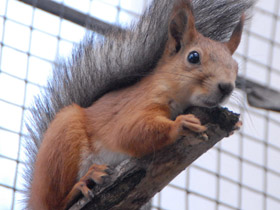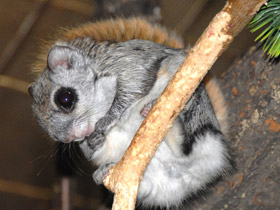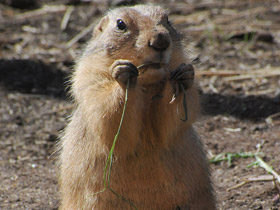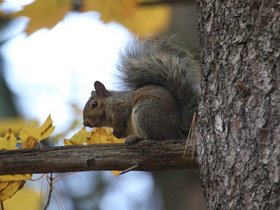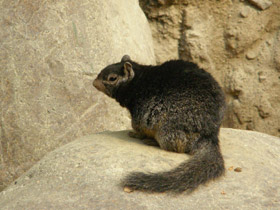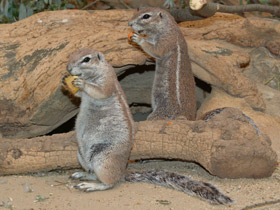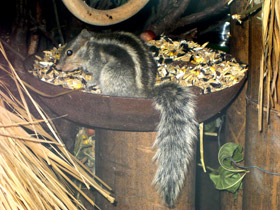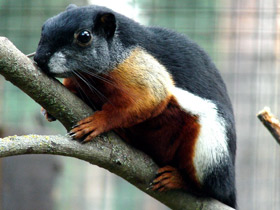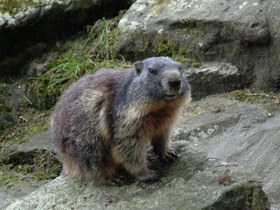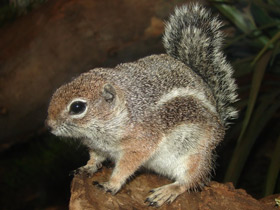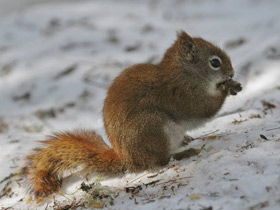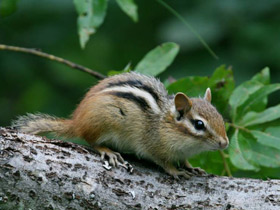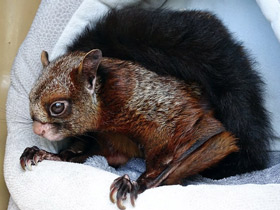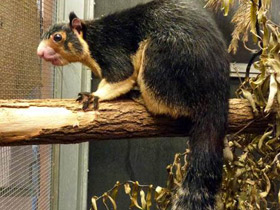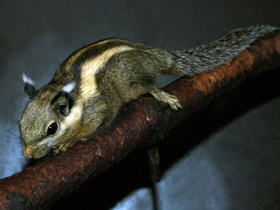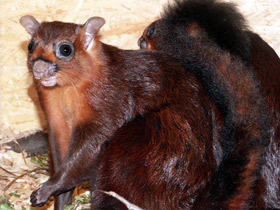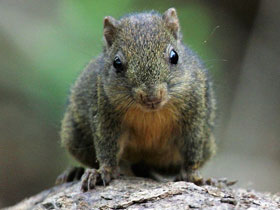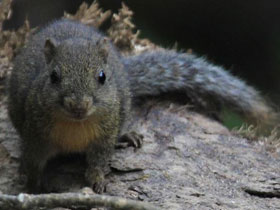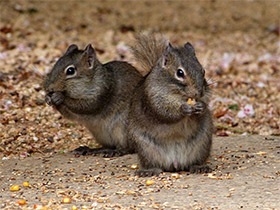The family Sciuridae
Squirrels are members of the family Sciuridae (/sɪˈjuːrɪdeɪ, -diː/), a family that includes small or medium-size rodents. The squirrel family includes tree squirrels, ground squirrels (including chipmunks and prairie dogs, among others), and flying squirrels. Squirrels are indigenous to the Americas, Eurasia, and Africa, and were introduced by humans to Australia. The earliest known fossilized squirrels date from the Eocene epoch, and among other living rodent families, the squirrels are most closely related to the mountain beaver and to the dormice.
Etymology
The word squirrel, first attested in 1327, comes from the Anglo-Norman esquirel which is from the Old French escurel, the reflex of a Latin word sciurus, which was taken from the Ancient Greek word σκίουρος (skiouros; from σκία-ουρος) 'shadow-tailed', referring to the long bushy tail which many of its members have.
The native Old English word for the squirrel, ācweorna, only survived into Middle English (as aquerne) before being replaced. The Old English word is of Common Germanic origin, cognates of which are still used in other Germanic languages, including the German Eichhörnchen (diminutive of Eichhorn, which is not as frequently used); the Norwegian ikorn/ekorn; the Dutch eekhoorn; the Swedish ekorre and the Danish egern.
A group of squirrels is called a "dray" or a "scurry".
Many juvenile squirrels die in the first year of life. Adult squirrels can have a lifespan of 5 to 10 years in the wild. Some can survive 10 to 20 years in captivity. Premature death may occur when a nest falls from the tree, in which case the mother may abandon her young if their body temperature is not correct. Many such baby squirrels have been rescued and fostered by a professional wildlife rehabilitator until they could be safely returned to the wild, although the density of squirrel populations in many places and the constant care required by premature squirrels means that few rehabilitators are willing to spend their time doing this and such animals are routinely euthanized instead.
Stated purposes of squirrels' tails, to benefit the squirrel, include:
- To keep rain, wind, or cold off itself.
- To cool off when hot, by pumping more blood through its tail.
- As a counterbalance when jumping about in trees.
- As a parachute when jumping.
- To signal with.
The hairs from squirrel tails are prized in fly fishing when tying fishing flies. A special quality of squirrel tail hair is that it is all guard hairs, not undercoat.
When the squirrel sits upright, its tail folded up its back may stop predators looking from behind from seeing the characteristic shape of a small mammal.
Taxonomy
The living squirrels are divided into five subfamilies, with about 58 genera and some 285 species. The oldest squirrel fossil, Hesperopetes, dates back to the Chadronian (late Eocene, about 40–35 million years ago) and is similar to modern flying squirrels.
A variety of fossil squirrels, from the latest Eocene to the Miocene, have not been assigned with certainty to any living lineage. At least some of these probably were variants of the oldest basal "protosquirrels" (in the sense that they lacked the full range of living squirrels' autapomorphies). The distribution and diversity of such ancient and ancestral forms suggest the squirrels as a group may have originated in North America.
Apart from these sometimes little-known fossil forms, the phylogeny of the living squirrels is fairly straightforward. The three main lineages are the Ratufinae (Oriental giant squirrels), Sciurillinae and all other subfamilies. The Ratufinae contain a mere handful of living species in tropical Asia. The neotropical pygmy squirrel of tropical South America is the sole living member of the Sciurillinae. The third lineage, by far the largest, has a near-cosmopolitan distribution. This further supports the hypothesis that the common ancestor of all squirrels, living and fossil, lived in North America, as these three most ancient lineages seem to have radiated from there; if squirrels had originated in Eurasia, for example, one would expect quite ancient lineages in Africa, but African squirrels seem to be of more recent origin.
The main group of squirrels can be split into five subfamilies. The Callosciurinae, 60 species mostly found in South East Asia; the Ratufinae 4 cat-sized species found in south and southeast Asia; the Sciurinae contains the flying squirrels (Pteromyini) and the tree squirrels, 83 species found world wide; Sciurillinae a single South American species; and Xerinae includes three tribes of mostly terrestrial squirrels, including the Marmotini (marmots, chipmunks, prairie dogs, and other Holarctic ground squirrels), Xerini (African and some Eurasian ground squirrels), and Protoxerini (African tree squirrels).
Taxonomy list
Basal and incertae sedis Sciuridae (all fossil)
- Hesperopetes;
- Kherem;
- Lagrivea;
- Oligosciurus;
- Plesiosciurus;
- Prospermophilus;
- Sciurion;
- Similisciurus;
- Sinotamias;
- Vulcanisciurus:
- Subfamily Cedromurinae (fossil);
- Subfamily Ratufinae – Oriental giant squirrels (1 genus, 4 species);
- Subfamily Sciurillinae – neotropical pygmy squirrel (monotypic);
- Subfamily Sciurinae:
- Tribe Sciurini – tree squirrels (5 genera, about 38 species);
- Tribe Pteromyini – true flying squirrels (15 genera, about 45 species);
- Subfamily Callosciurinae – Asian ornate squirrels:
- Tribe Callosciurini (13 genera, nearly 60 species);
- Tribe Funambulini palm squirrels (1 genus, 5 species);
- Subfamily Xerinae – terrestrial squirrels:
- Tribe Xerini – spiny squirrels (3 genera, 6 species);
- Tribe Protoxerini (6 genera, about 50 species);
- Tribe Marmotini – ground squirrels, marmots, chipmunks, prairie dogs, etc. (6 genera, about 90 species).

















